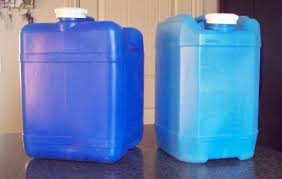Let's do a trial run for a day. Let's pretend we have no running water and keep track of the times we would have used it.
Way back in my very first blog post I think I mentioned water - along with things like toilet paper and other important items.
Here goes:
You get up in the morning and hit the bathroom - once would be ok cause there is water in the toilet tank but what if you don't live alone or don't choose to potty only once a day. What do you do then?
Ah, time to brush your teeth - no water - in a pinch a bottle of that designer stuff would work. And you could wet a washcloth to at least wash the sleep out of your eyes.
Shower? Not unless it's raining out and then it'd better be a private neighborhood and August!
Breakfast - coffee....oops, well, more designer water would work.
Breakfast dishes - no running water, remember?
Wash your hands - no running water
Shampoo your hair - how many bottles of that designer water do you actually have?
And so on and so forth throughout the day. Dishes continue to pile up unless you have a lot of paper plates and cups.
Chopping vegetables for supper (need clean hands) and needing water to cook them in. Oh yea, no running water :(
If you take a few minutes throughout the day to actually notice how many times you reach for a faucet you might be surprised. You also might be interested in how easy it is to store water for those "no running water" times.
There are a variety of plastic containers that you can use - most of which you are already throwing in the recycle (or, heaven forbid, the trash) without a thought to giving them a second lease on life. Easy enough (while you still have that running water going on) to rinse or wash them out and just fill them with tap water. If you think you might want to store them for a while a few drops of (unscented) bleach will keep them fresh for months!

Please take note that the above "proper" storage containers all have covers and are all made of impermeable materials (that means the water doesn't suck the bad stuff out of the container - like lead in pottery or just plain dirt in other open topped containers). But also notice that they don't have to be fancy - any clean covered container will do as long as it's not permeable (see above!).
You can also gather rain water - a subject best covered in it's own separate post because it is a bit more complicated and needs more materials.
There is also the local department store (see, I did not say Walmart!) for a "real" water storage container such as:


Or you can go big time and get ones like these:

Some even come with their own pumps so you can easily get the water out. You'd be stylin' then!

Something to consider - especially if you don't have a lot of upper body strength (see I didn't say "if you are a woman") - is how you are going to get the water to where you want to use it. That is why the very first store bought container picture I put on here is smaller than some of the others. It's much easier to transfer the water from a large container into a more portable one that you can use wherever you need the water than it is to try to horse around the big ones. It's actually how I manage my gas supply for the snow blower etc - I can't lift the big 5 gallon gas cans high enough to gas up a machine but I can tip and pour the gas through a funnel into a small gas can and use it from there.
How probable are any of us to be without household water for an extended period of time? Probably not so much - of course if you are on a well as I am and lose power it's more likely. How much of an inconvenience would it be in that unlikely event? Pretty darn!
So same drum different subject: invest a little time and maybe a little money so you will be the one who's got the clean dishes, the sparkling toilet and shiny hair if running water stops....running!

